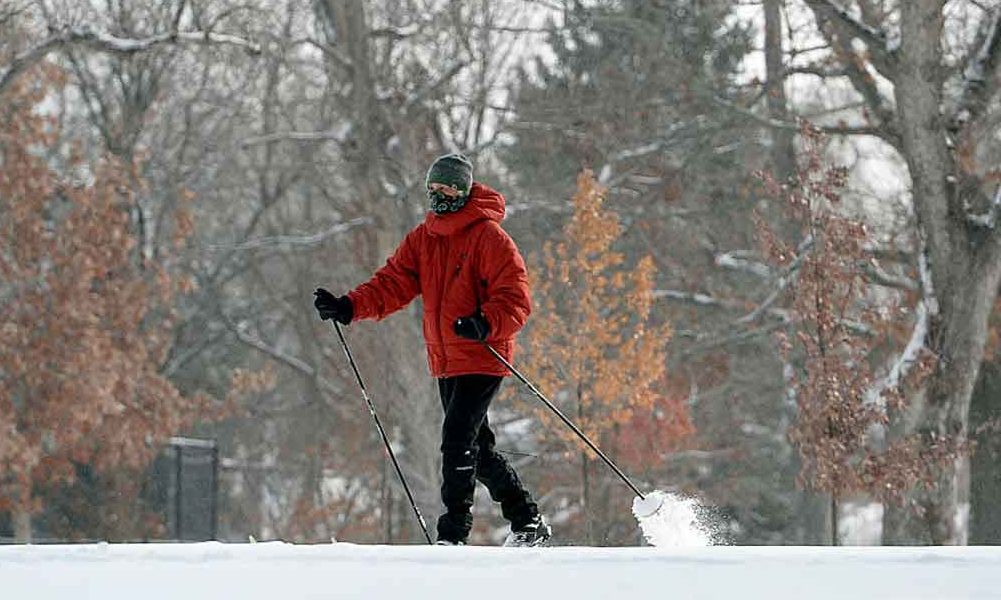Winter Sports Will Keep You Fit

Don’t let cold or snow stop you from exercising outdoors. If you make outdoor winter exercise a part of your life, you'll be less likely to suffer the winter blues.
If winter gets you down, one of the best remedies is to go outdoors in sunlight and move. Wouldn’t it be great if a forecast of snow or a cold snap made your heart sing? Moving your body in a winter landscape has a unique magic — at once invigorating and peaceful.
Fancy ski vacations are alluring, but you’ll probably be happier if you make outdoor winter exercise a part of your life beyond vacations. Ice skating, cross-country skiing, and snow shoeing are much cheaper and easily available in some parts of the United States.
YOU MIGHT ALSO LIKE: Exercising Outdoors in the Winter
Stay warm when you exercise during winter
The key to being safe is your clothing. Never exercise outdoors during cold weather wearing jeans, cotton T-shirts, or cotton socks. When cotton is wet, it gets heavy, making you colder. Invest in silk or synthetic long underwear, a layer of fleece or wool, and a waterproof windbreaker.
Be careful if you have asthma
Keep a face mask, scarf, or balaclava handy to cover your mouth if you have asthma. Dry air can trigger symptoms. You’ll be safe when you exhale air you moistened during breathing.
Don’t overdress. You shouldn’t feel toasty during the first five minutes outdoors. You can count on warming up as you move and should eventually remove your hat and unzip your jacket. Sweat will make you colder later.
Ice skating
You don’t need a special outfit, just avoid cotton. Wear synthetic leggings over silk or synthetic long underwear. When you rent skates, take your time finding the right size. Most skate rinks have rubber matting you can walk on. Walk a bit (with the skate guards on) to establish your center of gravity.
When you get on the ice, walk around the inside, holding the wall to balance yourself if you’re at a rink. If you’re a novel skater, have a friend or instructor teach you how to stop, fall, and stand again.
Cross-country skiing and snow shoeing
In snowy areas, you’re likely to find trails or open land at a golf course or park. Once you learn the sport, you can bring your own equipment (which is much cheaper and manageable than downhill ski boots and skis) and play outside during the week or weekend.
For an excursion, check out any place where you hike. Farms, downhill ski resorts, or state parks may groom the trails, rent out equipment, and provide lessons. If you skip formal lessons, make sure you know how to stop, fall, and stand afterwards.
Both activities are good for seniors. They’re gentle on your knees, while boosting balance and strengthening your legs and buttock muscles.
If you like to ski downhill, you’ll probably get a more aerobic workout with the cross-country version, since you won’t be spending time waiting for a lift. Cross-country trails are also likely to give you a more intimate experience of a mountain. You’ll still need a lesson, even if you’re an experienced skier, to learn different techniques.
Once you’re past the beginner stage, you’ll be able to weave between trees and alongside frozen ponds and streams.
Use your poles, and you’ll get a full-body workout and burn more calories per hour.
Practice common sense
For all outdoor winter sports, it’s important to remember to drink water. You might not notice you’re sweating and become dehydrated. Bring dark chocolate and nuts in a backpack.
If you’re out on a trail, keep track of the time and when it will get dark. Bring your cell phone, but you may not have reception. You can bring a buddy for safety and social engagement.
Updated:
January 16, 2024
Reviewed By:
Janet O’Dell, RN